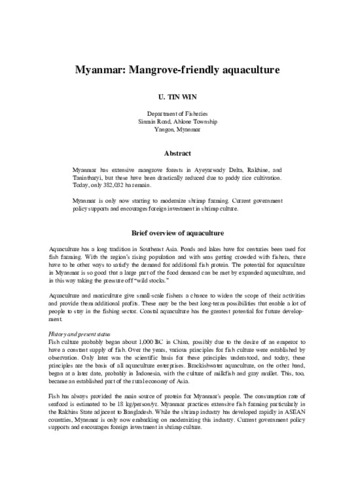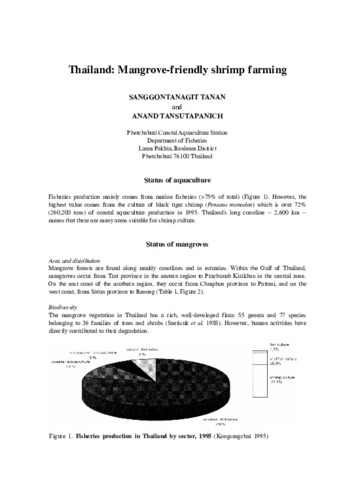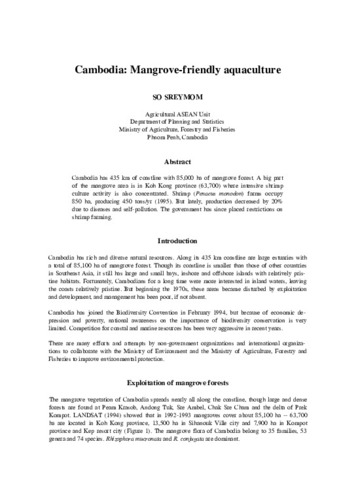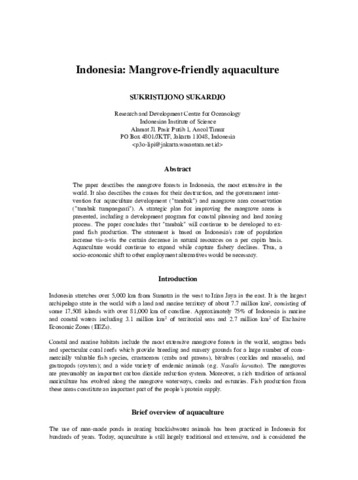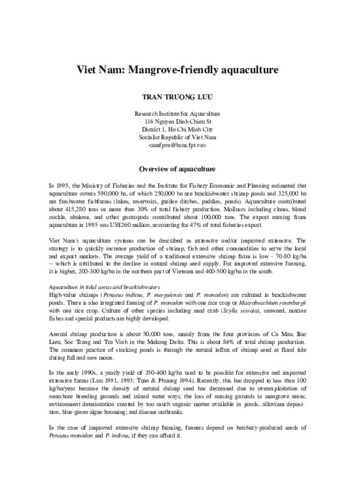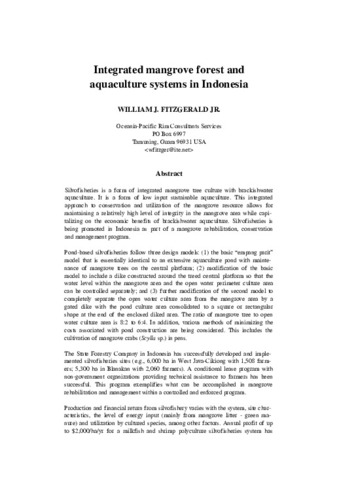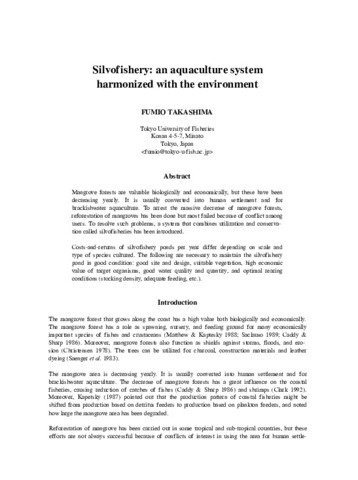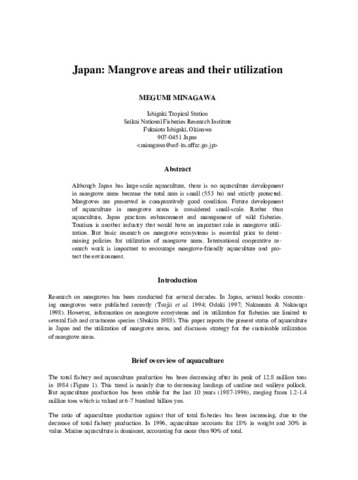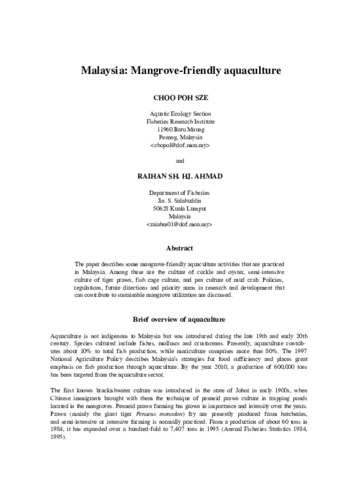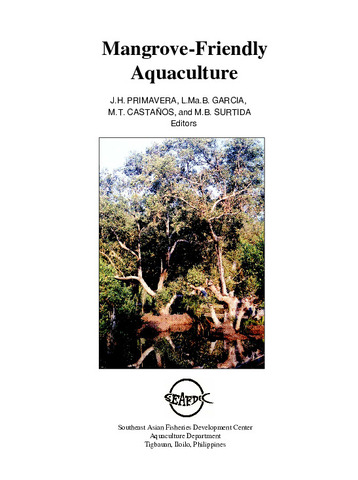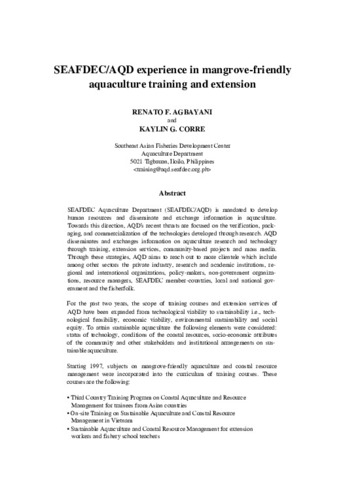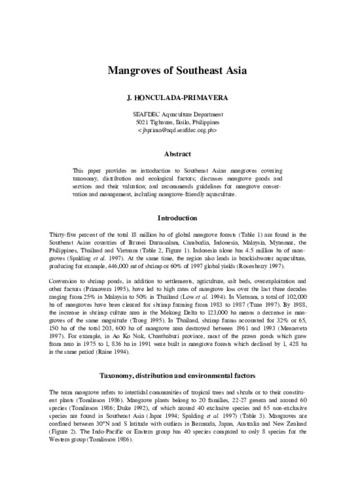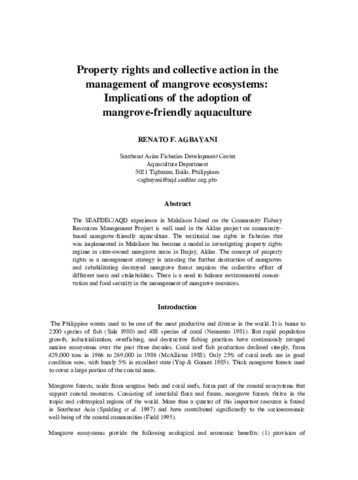Mangrove Friendly Aquaculture
Proceedings of the Workshop on Mangrove-Friendly Aquaculture organized by the SEAFDEC Aquaculture Department, January 11-15, 1999, Iloilo City, Philippines
The proceedings has three review papers on the mangroves of Southeast Asia, silvofisheries, and Indonesia's integrated mangrove forest and aquaculture systems. The rest of the papers, all on mangrove-friendly aquaculture efforts are from the Philippines, Japan, Thailand, Vietnam, Malaysia, Brunei Darussalam, Indonesia, and Cambodia. All the countries represented had varied methodologies, with Cambodia in its initial stages while some countries like Indonesia and Thailand have tested methodologies. The proceedings include a tabulation of the reported mangrove-friendly technology by country -- e.g. silvofisheries in ponds (mangrove and fish/shrimp/mudcrab) and pens (mangrove and mudcrab). The workshop recommendations are classified into three major topics: problems associated with mangroves, problems associated with aquaculture practices, and socioeconomic and cultural issues.
Contents
- Publisher's note
- Foreword
- Background of the workshop
- Review papers
-
Mangroves of Southeast Asia
J. Honculada-Primavera -
Silvofishery: an aquaculture system harmonized with the environment
F. Takashima -
Integrated mangrove forest and aquaculture systems in Indonesia
W.J. Fitzgerald Jr
-
Mangroves of Southeast Asia
- Country efforts on mangrove-friendly aquaculture
-
Japan: mangrove areas and their utilization
M. Minagawa -
Philippines: mangrove-friendly aquaculture
S. Aypa and S. Baconguis -
Thailand: mangrove-friendly shrimp farming
S. Tanan and A. Tansutapanich -
Viet Nam: Mangrove-friendly aquaculture
T. Luu -
Malaysia: mangrove-friendly aquaculture
P.S. Choo and S.A. Raihan -
Brunei Darussalam: mangrove-friendly aquaculture
L. Abdul Hamid -
Indonesia: mangrove-friendly aquaculture
S. Sukardjo -
Cambodia: mangrove-friendly aquaculture
S. Sreymom -
Myanmar: mangrove-friendly aquaculture
U. Win
-
Japan: mangrove areas and their utilization
- SEAFDEC/AQD experience papers
-
Marine fishes and coastal resource management: mangrove-friendly development strategies
L.M.aB. Garcia, J.D. Toledo, and R.F. Agbayani -
Property rights and collective action in the management of mangrove ecosystems: implications of the adoption of mangrove friendly-aquaculture
R.F. Agbayani -
Mud crab (Scylla serrata) culture in tidal flats with existing mangroves
A.T. Triño and E.M. Rodriguez -
Mangrove-associated mollusc research at SEAFDEC/AQD
T.R. de Castro-Mallare -
SEAFDEC/AQD experience in mangrove-friendly aquaculture training and extension
R.F. Agbayani and K.G. Corre
-
Marine fishes and coastal resource management: mangrove-friendly development strategies
- Available mangrove-friendly technologies
- Workshop recommendations
- List of participants and observers
- Acknowledgments
最新登録資料
-
Myanmar: Mangrove-friendly aquaculture
(Aquaculture Department, Southeast Asian Fisheries Development Center, 2000)Myanmar has extensive mangrove forests in Ayeyarwady Delta, Rakhine, and Tanintharyi, but these have been drastically reduced due to paddy rice cultivation. Today, only 382,032 ha remain. Myanmar is only now starting ... -
Thailand: Mangrove-friendly shrimp farming
(Aquaculture Department, Southeast Asian Fisheries Development Center, 2000) -
Cambodia: Mangrove-friendly aquaculture
(Aquaculture Department, Southeast Asian Fisheries Development Center, 2000)Cambodia has 435 km of coastline with 85,000 ha of mangrove forest. A big part of the mangrove area is in Koh Kong province (63,700) where intensive shrimp culture activity is also concentrated. Shrimp (Penaeus monodon) ... -
Indonesia: Mangrove-friendly aquaculture
(Aquaculture Department, Southeast Asian Fisheries Development Center, 2000)The paper describes the mangrove forests in Indonesia, the most extensive in the world. It also describes the causes for their destruction, and the government intervention for aquaculture development ("tambak") and mangrove ... -
Viet Nam: Mangrove-friendly aquaculture
(Aquaculture Department, Southeast Asian Fisheries Development Center, 2000) -
Philippines: Mangrove-friendly aquaculture
(Aquaculture Department, Southeast Asian Fisheries Development Center, 2000)Mangrove areas in the Philippines were once considered vast tracts of wasteland that can be developed into other land uses. The economic "advantages" associated with such exploitation were considered socially "valuable" ... -
Integrated mangrove forest and aquaculture systems in Indonesia
(Aquaculture Department, Southeast Asian Fisheries Development Center, 2000)Silvofisheries is a form of integrated mangrove tree culture with brackishwater aquaculture. It is a form of low input sustainable aquaculture. This integrated approach to conservation and utilization of the mangrove ... -
Silvofishery: An aquaculture system harmonized with the environment
(Aquaculture Department, Southeast Asian Fisheries Development Center, 2000)Mangrove forests are valuable biologically and economically, but these have been decreasing yearly. It is usually converted into human settlement and for brackishwater aquaculture. To arrest the massive decrease of mangrove ... -
Japan: Mangrove areas and their utilization
(Aquaculture Department, Southeast Asian Fisheries Development Center, 2000)Although Japan has large-scale aquaculture, there is no aquaculture development in mangrove areas because the total area is small (553 ha) and strictly protected. Mangroves are preserved in comparatively good condition. ... -
Brunei Darussalam: Mangrove-friendly aquaculture
(Aquaculture Department, Southeast Asian Fisheries Development Center, 2000)Aquaculture in Brunei Darussalam is quite recent compared to other countries. Cage culture of marine fishes and pond culture of marine shrimp are popular. Mangrove area utilized for aquaculture (shrimp ponds) is very ... -
Malaysia: Mangrove-friendly aquaculture
(Aquaculture Department, Southeast Asian Fisheries Development Center, 2000)The paper describes some mangrove-friendly aquaculture activities that are practiced in Malaysia. Among these are the culture of cockle and oyster, semi-intensive culture of tiger prawn, fish cage culture, and pen culture ... -
Mangrove-Friendly Aquaculture : Proceedings of the Workshop on Mangrove-Friendly Aquaculture organized by the SEAFDEC Aquaculture Department, January 11-15, 1999, Iloilo City, Philippines
(Aquaculture Department, Southeast Asian Fisheries Development Center, 2000)The proceedings have three review papers on the mangroves of Southeast Asia, silvofisheries, and Indonesia's integrated mangrove forest and aquaculture systems. The rest of the papers, all on mangrove-friendly aquaculture ... -
SEAFDEC/AQD experience in mangrove-friendly aquaculture training and extension
(Aquaculture Department, Southeast Asian Fisheries Development Center, 2000)SEAFDEC Aquaculture Department (SEAFDEC/AQD) is mandated to develop human resources and disseminate and exchange information in aquaculture. Towards this direction, AQD’s recent thrusts are focused on the verification, ... -
Mangroves of Southeast Asia
(Aquaculture Department, Southeast Asian Fisheries Development Center, 2000)This paper provides an introduction to Southeast Asian mangroves covering taxonomy, distribution and ecological factors; discusses mangrove goods and services and their valuation; and recommends guidelines for mangrove ... -
Marine fishes and coastal resource management: mangrove-friendly development strategies
(Aquaculture Department, Southeast Asian Fisheries Development Center, 2000)Recent statistics of fishery production in the Philippines reveal outputs that are either declining (municipal fishery) or levelling off (commercial fishery and aquaculture). These trends are, in part, a reflection of the ... -
Property rights and collective action in the management of mangrove ecosystems: Implications of the adoption of mangrove friendly-aquaculture
(Aquaculture Department, Southeast Asian Fisheries Development Center, 2000)The SEAFDEC/AQD experience in Malalison Island on the Community Fishery Resources Management Project is well used in the Aklan project on community-based mangrove-friendly aquaculture. The territorial use rights in fisheries ... -
Mangrove-associated mollusc research at SEAFDEC/AQD
(Aquaculture Department, Southeast Asian Fisheries Development Center, 2000)Mollusc research at the Aquaculture Department of the Southeast Asian Fisheries Development Center started in 1975 and focused on two commercially important mangrove-associated bivalves, the slipper-shaped oyster (Crassostrea ... -
Mud crab (Scylla serrata) culture in tidal flats with existing mangroves
(Aquaculture Department, Southeast Asian Fisheries Development Center, 2000)The performance of the mud crab Scylla serrata (Forsskal) in 200 m2 pens installed in tidal flats with existing mangroves was determined in a factorial experiment with stocking density (0.5 or 1.5/m2) ...

